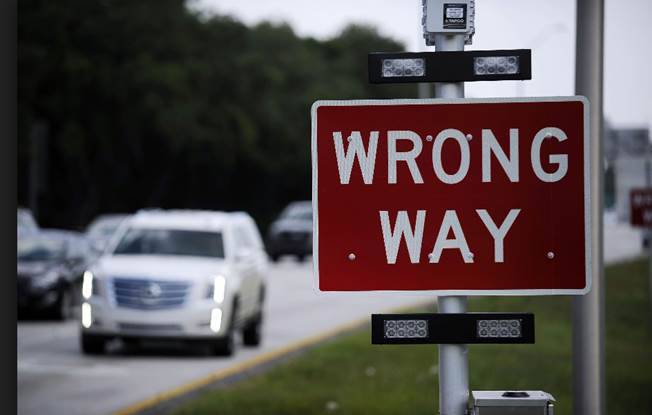
Courtesy of NDOT
NDOT will install wrong-way detection signs like this at the Interstate 15-Starr Avenue interchange under construction now.
Friday, Dec. 8, 2017 | 2 a.m.
A new detection system to help prevent wrong-way crashes will be part of an interchange under construction in the south Las Vegas Valley.
There were 279 wrong-way driver crashes on Nevada’s freeway systems from 2005 to 2015, according to the Nevada Department of Transportation. They resulted in 41 fatalities and 125 injuries.
After researching ways to address the problem, NDOT determined a system using vehicle detection, cameras and red rectangular rapid-flashing beacons should be employed.
To implement the system, NDOT requested and received permission from the Federal Highway Administration to experiment with the beacons. Permission was needed because red rapid rectangular-flashing beacons are not allowed, per federal standards.
The first-of-its-kind system in the state will be installed at the Interstate 15/Starr Avenue interchange, which broke ground last week. Plans call for two units, costing $100,000-$150,000 each. Plans also call for the wrong-way driver detection system at the Kyle Canyon Road interchange, which breaks ground next year.
“The wrong-way signs are pole-mounted, electrically powered and self-contained,” NDOT spokesman Tony Illia said. “Flashing red lights mounted atop and below the ‘wrong way’ sign activate, flashing a warning. Drivers react to flashing alerts and routinely self-correct.”
Wrong-way driving crashes claim an average of 360 lives annually on U.S. roadways. These types of accidents are often caused by impaired or confused drivers, according to NDOT.
In September, a suspected intoxicated driver drove the wrong direction in the northbound lanes of Interstate 15, resulting in a multivehicle crash near Lamb Boulevard. Two people were hospitalized with minor injuries.
“As wrong-way accidents become more commonplace, traffic professionals have been tasked with preventing these deadly collisions,” Illia said. “Wrong-way detection signs have been proven to reduce wrong-way events by 38 percent, according to the Texas Transportation Institute.”
NDOT will place cameras at or near the beginning of the ramp to monitor activity and measure the system’s effectiveness.
“When a wrong-way driver is detected, the red wrong-way flashing beacons will be activated and the camera will verify the event to show if the wrong-way driver turns around or enters,” Illia said. “The method to detect, verify and report a wrong-way driver is what we want to identify so that the department, dispatch and the state Department of Public Safety are all on the same page.”
